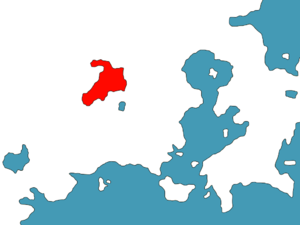Lake San Salvador
| Lake San Salvador | |
|---|---|
 | |
 | |
| Location | Central Sur |
| Group | Great Creeperian Lakes |
| Coordinates | |
| Type | Tectonic lake |
| Native name | Լագո Սան Սալվադոր Lago San Salvador |
| Etymology | "Lake of the Holy Savior" in Creeperian Spanish |
| Primary inflows | San Miguel River |
| Primary outflows | Asambio River |
| Basin countries | |
| Designation | Creeperopolis National Historical Landmark (since 15 September 1960) |
| Surface area | 23,858 sq mi (61,791 km2) |
| Max. depth | 2,589 ft (789 m) |
| Residence time | 284 years |
| Shore length1 | 935 mi (1504 km) |
| Islands | 28 (see list) |
| Settlements | Bautista, Escuinbulco, La'Mirada, La'Unión, La'Victoria, Nuevo San Salvador, San Salvador, San Salvador del Norte, South Serrada, Terrarote |
| 1 Shore length is not a well-defined measure. | |
Lake San Salvador (Creeperian Spanish – Creeperian: Լագո Սան Սալվադոր; Creeperian Spanish – Iberic: Lago San Salvador) is a tectonic lake in central Creeperopolis. It is the second largest lake in the world by surface area and the largest in Sur and the Southern Hemisphere. Water flows into the lake through the San Miguel River in the north and drains out to Lake Zapatista through the Asambio River in the south.
The lake is the fifth deepest in Creeperopolis with a maximum depth of 2,589 feet (789 meters), and has a shoreline of approximately 935 miles (1504 kilometers). It is categorized as a member of the Great Creeperian Lakes group, along with Lake Atlántida, Lake Castilliano, and Lake Zapatista.
Contents
Etymology
Lake San Salvador is named after Jesus Christ, the central figure of Christianity and the Creeperian Catholic Church. Lake San Salvador means "Lake of the Holy Savior" in Creeperian Spanish, where it is rendered as Լագո Սան Սալվադոր (Creeperian Script) or Lago San Salvador (Iberic Script).
The Hondurans referred to the lake as "The Great Lake" (Honduran: Aintzira Handia). The lake was known as the "Lake of the Messenger" (Deltinian: بحيرة الرسول; transliterated as Buhayrat al-Rasul or Buhayrat Alrasul). The name was in reference to Muhammad, the central figure and most important prophet of Islam, and was used from the 10th century to the 14th century. The lake was also known as the "Lake of the Victory" (Lago de la'Victoria) from the 14th century until the mid-16th century, as it was called by the Kingdom of Creeperopolis. During the mid-16th century, the lake it became known as Lake San Salvador.
During the Creeperian Civil War, as a part of its Secularization process, the National Council for Peace and Order temporarily renamed the lake to "Great Central Lake" (Gran Lago Central) in 1933. In 1934, the National Council renamed the lake to "Lake Ordóñez Yepes" (Lago Ordóñez Yepes), commemorating National Liberal politician Inhué Ordóñez Yepes. The name change was not recognized by the opposing Catholic Imperial Restoration Council which retained the name Lake San Salvador; the name Lake Ordóñez Yepes was abandoned following the end of the civil war in 1949.
Geography
Lake San Salvador is the second largest lake in the world after Lake Manal in central Ecros, and it is the largest lake in Sur and the southern hemisphere. Being the second largest fresh water lake in the world, Lake San Salvador, holds 8% of the world's fresh water.
Islands
The lake has twenty-eight islands, with the largest being Isla San Romero, which itself has two lakes on it with one of the lakes containing an island. All of the islands of Lake San Salvador in order of largest to smallest are:
- Isla San Romero
- Isla de la'Gran Victoria
- Isla Puyal Cisneros
- Isla Bendita
- Isla San Salvador
- Isla Santa Ana
- Isla Punto Norte
- Isla del Santo Bautista
- Isla Miguel I
- Isla de Jesús
- [[
- [[
- [[
- [[
- [[
- [[
- [[
- [[
- [[
- [[
- [[
- [[
- [[
- [[
- [[
- [[
- [[
- [[

